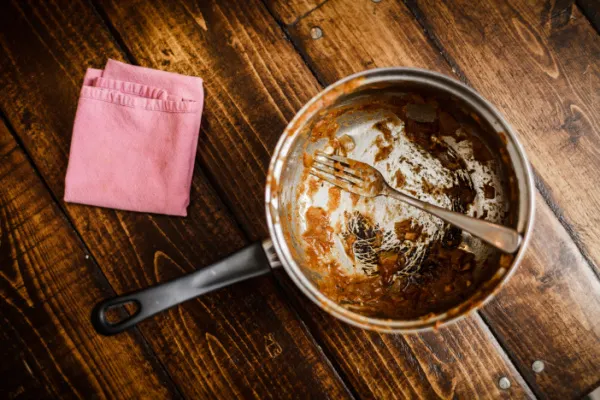
A Step-by-Step Guide to Cleaning the Most Difficult Dishes
Some recipes are much easier to clean than others. Dried-on foods, burnt meat, melted sugar and tomato bases can leave sticky messes and lingering residues that seem impossible to wash. Below, we highlight some of the most frustrating dishes to clean—and a DIY guide to tackling those messes.
Top 5 Worst Dishes to Clean
- Cheesesteak: Often prepared in a frying pan, cheesesteak is double-difficult, combining burnt meat and melted cheese into one frustrating mess. Even the most vigorous scrubbing won’t do the trick—although you may burn off a few of those extra cheesesteak calories!
- Lasagna: The classic hard-to-clean dish boasts both tomatoes and cheese to make cleaning extra-frustrating (especially those hard-to-reach corners of the casserole dish). Don’t be fooled by detergent commercials — a simple cycle through the dishwasher will not suffice!
- Quiche: Pairing quickly drying egg with cheese and tomato causes quiche pans to be subject to dried-on food and pasty tomato residue—two dirty dish nightmares. You spend all morning preparing your quiche. You don’t want to spend all afternoon cleaning the pie pan!
- Oatmeal: The starchiness of oatmeal, when dried, forms a glue-like paste that is no fun to clean. What do you do when your breakfast bowl looks like a botched papier-mâché project? Hint: It doesn’t require a chisel and hammer.
- Coffee: Allowing coffee to sit in a mug untouched can leave stains that don’t come out in a regular wash. Not only do the stains linger, but so does the taste. Avoid drinking last week’s coffee by thoroughly cleaning your mugs.
How to Tackle the Toughest Dirty Dishes
For those daunting dishes, follow these quick and easy steps to have your pots and pans looking and smelling as clean as ever. That way, you can spend less time scrubbing and more time doing the things you love—like trying even more new recipes! Keeping your dishes clean can be an exhausting feat. Let Molly Maid’s cleaning service take care of the rest! Although Molly Maid’s staff doesn’t clean dishes, let us clean the rest of the house so you can do what you really enjoy. Contact your local Molly Maid online or call us!
What You’ll Need:
- Gloves
- Vinegar
- Dishwasher detergent
- Dish soap
- Towel or rag
- Scrubbing brush or coarse sponge
- Baking soda
Step-by-Step Guide:
- Safety first, put on some rubber gloves to keep your hands safe from grease and oil.
- Grab the dirty dish and fill it with hot water and a few drops of the detergent. (Pro tip: The hotter the water, the better. Hot water can cut through tough messes, just be careful not to make the water so hot that you’ll burn yourself! The only exception to the rule is dairy-related foods. Dairy tends to grow stickier with warm water—so cold water is best for cleaning cheesy dishes.)
- Let the pan soak for anywhere between 20 minutes and two hours, depending on the dish’s dirtiness. (Pro tip: If you’re cleaning a regular (not a nonstick) stovetop pan or pot, put the pan over a burner set on high to speed up the degreasing process.)
- After soaking, empty the water and pour some baking soda into the pan.
- Using a wet, course sponge or brush and a few drops of dish soap, scrub the pot—really put some elbow grease into it!
- Using hot water again, wash the soap off your pot.
- If there’s still some residue, repeat through step 6 until clean.
- If your pot appears burnt and steps 1 through 7 aren’t helping, try covering the surface area of the pot with baking soda and pouring vinegar into it—wait while the chemical reaction occurs and wipe away with your soapy sponge.
- With freshly cleaned dishes in hand, use a dry rag to wipe away the remaining water before storage.
- Equipped with a clean pan, you’re ready for a new recipe!
